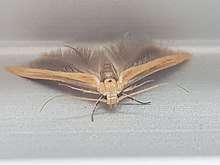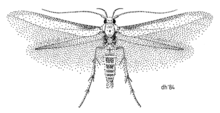Stathmopoda skelloni
Stathmopoda skelloni, the yellow featherfoot, is a species of moth in the Stathmopodidae family.[3] It is endemic to New Zealand.
| Stathmopoda skelloni | |
|---|---|
 | |
| Scientific classification | |
| Kingdom: | |
| Phylum: | |
| Class: | |
| Order: | |
| Family: | |
| Genus: | |
| Species: | S. skelloni |
| Binomial name | |
| Stathmopoda skelloni | |
| Synonyms[2] | |
| |
Taxonomy
This species was first described by Arthur Gardiner Butler in 1880 and named Boocara skelloni.[2][4] Butler named this species in honour of William Skellon who had sent various specimens he had collected in Blenheim to Butler.[4] In 1889 Edward Meyrick placed this species within the genus Stathmopoda.[5] The type specimen is held at the Natural History Museum, London.[2] The common name for this species is the yellow featherfoot.[6]
The name skelloni was previously incorrectly used for S. horticola, a similar looking species which can be distinguished by the more extensive markings on the forewing of that species.[7]
Description

Meyrick described this species as follows:
♂♀︎. 12-15mm. Head, palpi, and antennae pale whitish-ochreous. Thorax whitish-ochreous. Abdomen pale whitish-ochreous, greyish-tinged. Legs pale whitish-ochreous, anterior pair infuscated, apex of posterior tibiae grey. Forewings elongate, very narrow broadest near base, long-pointed ; whitish-ochreous, sometimes yellowish-tinged ; markings grey, very variable, sometimes partially margined by an ochreous suffusion ; normally an elongate spot on inner margin at 1⁄3, a second beneath costa in middle, a third in disc at 2⁄3, a fourth before apex, and a slender subcostal line from second spot to costa near apex, but these tend to be variously connected and confused ; sometimes a streak along fold, or along anterior part of costa ; rarely a dark ochreous-fuscous suffusion towards base of inner margin : cilia light grey, sometimes ochreous-tinged. Hindwings and cilia light grey.[5]
Distribution
This species is endemic to New Zealand and can be found in Taranaki, Wellington, Blenheim, Nelson, Christchurch, Dunedin, Lake Wakatipu and Invercargill.[1][5]
Habitat
S. skelloni is found in a variety of habitats including native forest, coastal dunes, shrubland as well as cultivated gardens and orchards.[7]
References
| Wikimedia Commons has media related to Stathmopoda skelloni. |
- "Stathmopoda skelloni (Butler, 1880)". www.nzor.org.nz. Landcare Research New Zealand Ltd. Retrieved 3 February 2018.
- Dugdale, J. S. (1988). "Lepidoptera - annotated catalogue, and keys to family-group taxa" (PDF). Fauna of New Zealand. 14: 108. Retrieved 3 February 2018.
- Gordon, Dennis P., ed. (2010). New Zealand inventory of biodiversity. Volume two. Kingdom animalia : chaetognatha, ecdysozoa, ichnofossils. Vol. 2. Christchurch, N.Z.: Canterbury University Press. p. 4463. ISBN 9781877257933. OCLC 973607714.
- Butler, A. G. (1880). "On a collection of Lepidoptera Heterocera from Marlborough Province, New Zealand". Cistula Entomologica. 2: 541–562 – via Biodiversity Heritage Library.
- Meyrick, Edward (May 1889). "Descriptions of New Zealand Micro-Lepidoptera". Transactions and Proceedings of the New Zealand Institute. 21: 154–188 – via Biodiversity Heritage Library.
- "Yellow Featherfoot (Stathmopoda skelloni)". iNaturalist.org. Retrieved 2019-02-04.
- Hoare, Robert J. B. (2014). A photographic guide to moths & butterflies of New Zealand. Ball, Olivier. Auckland: New Holland Publishers (NZ) Ltd. p. 36. ISBN 9781869663995. OCLC 891672034.